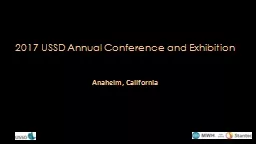

Anaheim California INVESTIGATING THE STRUCTURAL SAFETY OF CRACKED CONCRETE DAMS Glenn S Tarbox Robin Charlwood Chris Hayes Objective of Report The main purpose of the report ID: 573528
Download Presentation The PPT/PDF document "2017 USSD Annual Conference and Exhibiti..." is the property of its rightful owner. Permission is granted to download and print the materials on this web site for personal, non-commercial use only, and to display it on your personal computer provided you do not modify the materials and that you retain all copyright notices contained in the materials. By downloading content from our website, you accept the terms of this agreement.
Slide1
2017 USSD Annual Conference and ExhibitionAnaheim, CaliforniaSlide2
INVESTIGATING THE STRUCTURAL SAFETY OF CRACKED CONCRETE DAMS
Glenn S. Tarbox
Robin Charlwood
Chris HayesSlide3
Objective of ReportThe main purpose of the report
was to provide owners, operating staff, and engineers with a basic framework and practical tools for identifying cracks in the field and making wise decisions consistent with good international practice in the management of cracks.
Good practice requires that the engineers and operating staff of a dam be able to identify if a particular type of crack can lead to a dam safety problem, whether it is merely one to be routinely observed, or is a maintenance
or safety problem
that needs immediate attention.Slide4
Crack Evaluation and Management Logic Flowchart - Seven Steps
1. Discovery2. Crack Characterization
3. Review Dam Type & Construction Methods
4. Root Cause Analysis
5. Case Histories
6. Potential Failure Modes Analysis
7. Manage the CrackingSlide5Slide6
Types of Cracks Characterize and
document crack(s) by size (length, width and depth)
Open
, closed or
hairline; discrete or part of
a
pattern
Open cracks that penetrate deeply into or through the body of a dam regardless of location are usually more critical than shallow, hairline
cracks on parapet or
roadway
Hairline cracks may
be important indicators of internal mechanisms such as chemical expansion.
Cracks
that offset concrete on either side
can be significant
because they indicate differential movements
Cracks
that occur
either
parallel or perpendicular to
foundation are significant as dams rely on bond with their foundationsAny cracks through which water is leaking are significant because passage of water is unintended Slide7
Era of Concrete ConstructionShortcomings in early concrete mixing, delivery and consolidation techniques e.g. concrete having been “sluiced” and/or “chuted”. Slide8Slide9
Root Causes of Cracking Structural behavior
Foundation and abutment
behavior
Shrinkage
Thermal effects
Freeze-thaw effects
Chemical expansion
Earthquakes
Corrosion
of
rebar/embedded parts Slide10
Potential Failure Mode AnalysisEffective procedure to assess significance of cracking in concrete damsRational basis to develop a dam safety management plan
Developed by USBR and
used by
FERC since 2003 Slide11
Value of Case HistoriesProject Description, Relevance of Case Study, Description of cracking, Root Cause PFM Slide12
Koyna Dam Case History Cracking due to earthquakeSlide13
Managing Cracked DamsOptions for analyzing the causes and effects of cracks
Means
of monitoring the status of
cracks
Options
for controlling and/or reducing risks associated with the presence of the cracks in the dam. Slide14
Analysis of Causes and Effects Of Cracks
Provide
guidance on when analysis is recommended and suggestions of useful tools without emphasis on the details of the
tools
Structural, hydraulic, earthquake, ASR, etc.
Thermal Analysis
Stage Construction Studies Slide15
MonitoringAmerican Society of Civil Engineers (ASCE), “Guidelines for Instrumentation and Measurement for Monitoring Dam Performance.”
(revised edition expected in 2017)
CEATI, “
Dam Safety Performance Monitoring and Data Management – Best PracticesSlide16
Risk Reduction Measures Can Be Achieved by Affecting:Probability of an applied load.Probability of a particular response.
Probability of an unacceptable downstream consequence.
Dam owners have used one or a combination of these measures to lower the risk of a serious dam incident.
No general guidelines for implementing emergency actions are provided in the CEATI
Report.
The
need to take any such action must be determined on a case-by-case
basis.Slide17
ConclusionsConcrete dams crack for a variety of reasons.
It’s important
for owners
to
assess the significance of observed cracks
in
a timely and effective manner
.
The CEATI report provides
a
practical
framework
for identifying
cracks in the field and making wise decisions consistent with good international practice in the management of cracks.
If
a critical situation
is discovered where
a crack(s)
threatens
the safety of the dam, it must be immediately communicated to the dam safety engineer for response and action. Slide18
“Investigating the Structural Safety of Cracked Concrete Dams,” CEATI Report No. T122700-0226, April 2014
CEATI ReferenceSlide19
Acknowledgements MWH, now part of Stantec prepared the research report for CEATI International under the leadership of Chris Hayes, Vice President CEATI. The study was led by Glenn Tarbox with Robin Charlwood
with contributions from
Alain
Carrere from France
and
staff from
MWH/
Stantec
including Vik Iso-Ahola and Jennifer Fordney. Michael Manwaring of MWH
/Stantec
provided overall review.
The investigators are grateful to CEATI for the opportunity to have worked on this interesting issue, authored this technical paper and for contributions from the following individuals:
CEATI
Technical
Advisor
,
Gus Tjoumas
Project Monitors: Eric Bourdarot of EDF, A Anders Sjodin of ELFORSK, Jim Wagoner of OPG, and Dave Hart and Tony Deakin of Environment AgencySlide20
Thank You